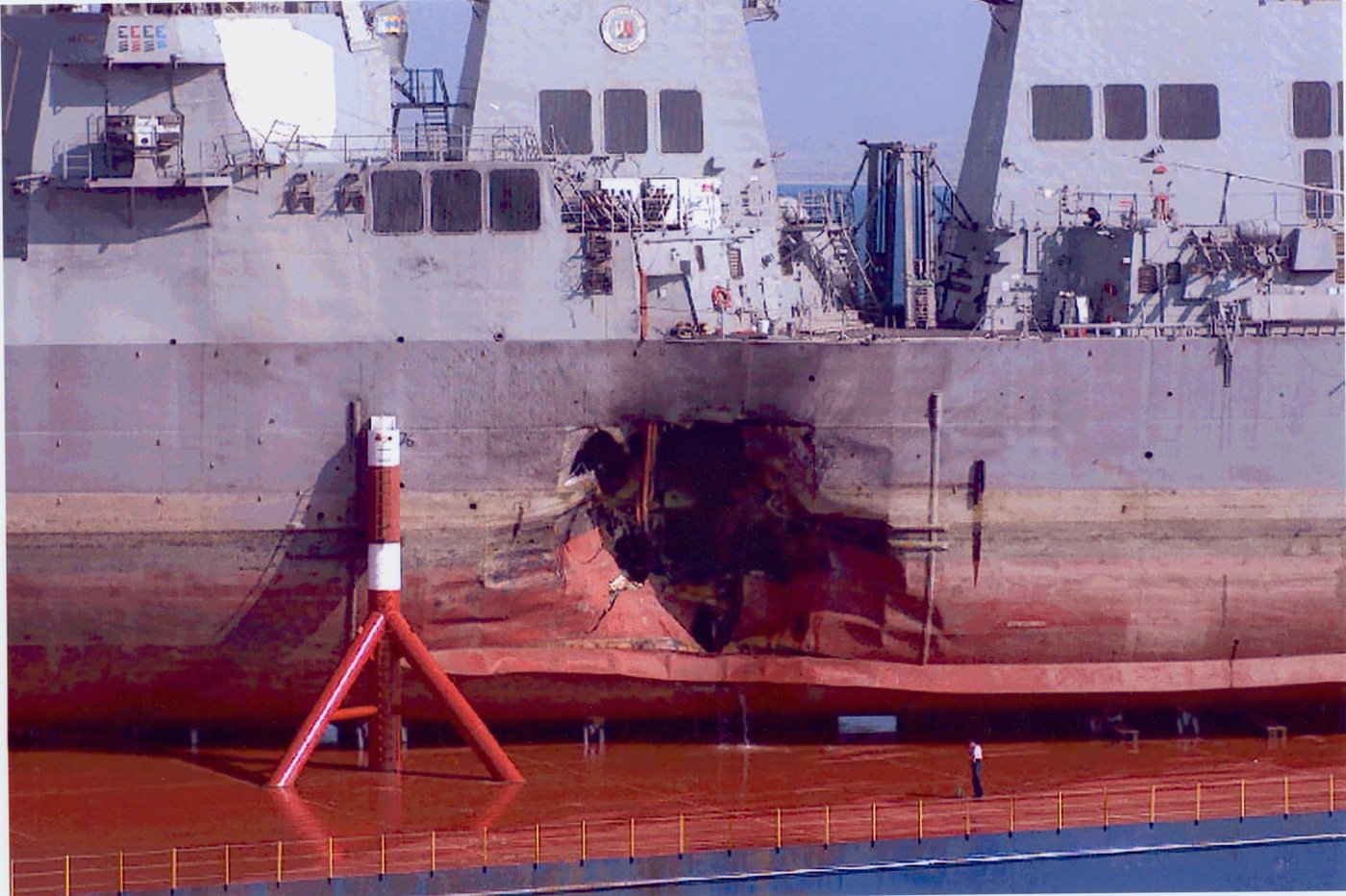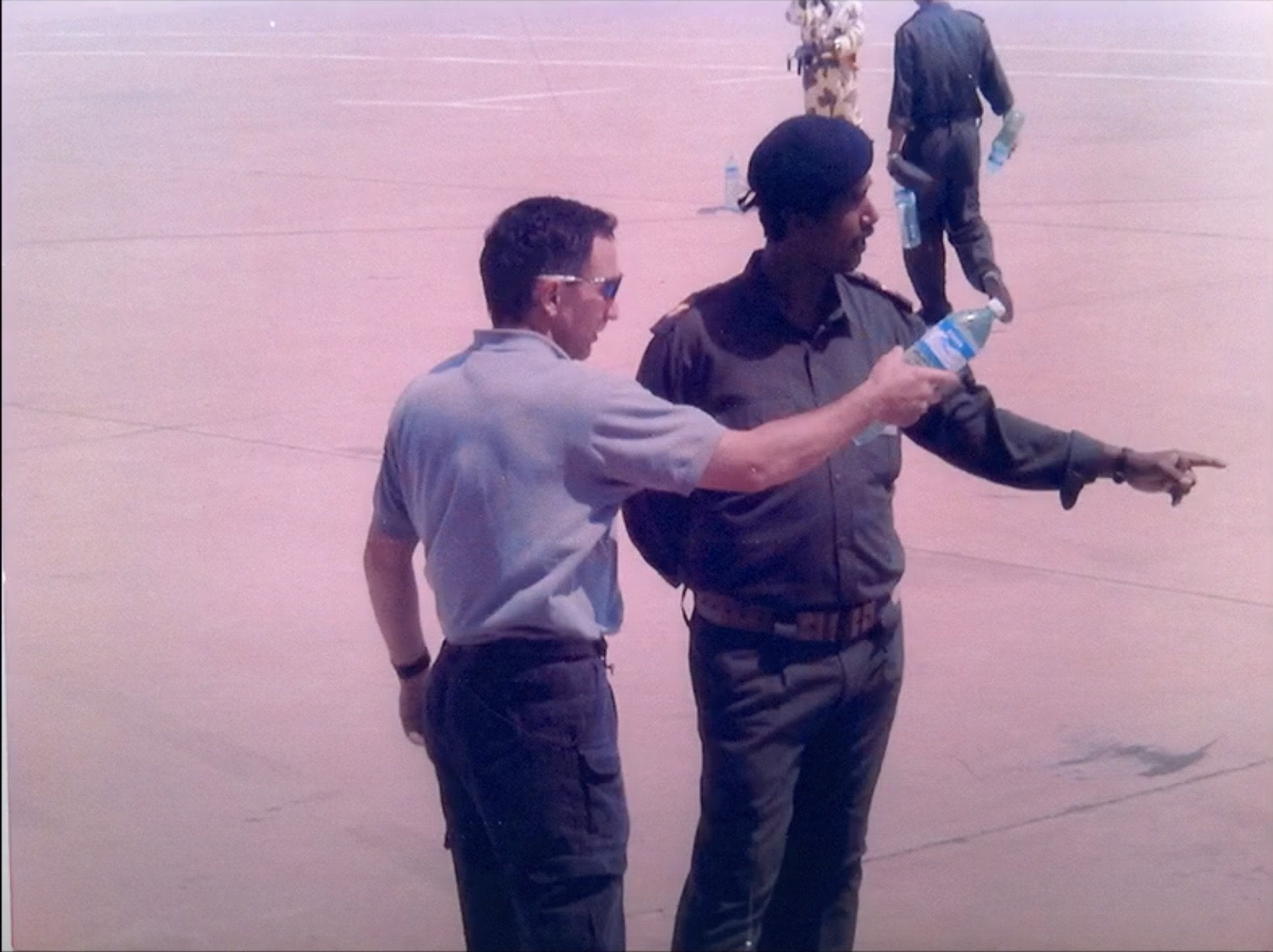
On October 12, 2000, suicide terrorists exploded a small boat alongside the USS Cole—a Navy Destroyer—as it was refueling in the Yemeni port of Aden. Photo courtesy of FBI.gov.
On Oct. 12, 2000, a small picket boat filled with hidden explosives approached the side of the USS Cole while she was refueling in Yemen’s Aden harbor and exploded. The blast by suicide bombers caused a gaping 40-foot hole in the destroyer’s hull in the area of the mess hall, where sailors were standing in the chow line.
“I finished what I was doing on the computer and as I stood up I got knocked down as the steel deck literally rippled beneath my feet,” reflected Christina Huber, the command career counselor of the Cole. “It felt like we got rammed in the back of the ship.”
The explosion killed 17 US Navy sailors and injured hundreds more. Rescue and recovery efforts began immediately, as well as an investigation into who was responsible for the terrorist attack. Ali Soufan, a 29-year-old FBI special agent — one of only eight or nine Arabic-speaking agents in the FBI at the time — was driving on the Brooklyn Bridge to the New York City field office when he learned of the bombing. His team from New York and from the National Capital Response Squad boarded a C-17 military aircraft for Yemen that day.

When the team of FBI agents from the Counterterrorism Division landed at the airport, they were met by Yemeni Special Forces and held at gunpoint. They were stranded on board with weeks’ worth of supplies — large pallets of food and water, weapons, vehicles, and other gear.
“Our first obstacle was that our host did not believe that the attack on the Cole was a result of a terrorist attack,” Soufan told PBS Frontline. “At the beginning they believed it was just an accident.”
Tim Clemente, another FBI special agent on the plane, watched Yemeni Special Forces dressed in yellow camouflage point at them with AK-47s, RPGs, and jeep-mounted .50-caliber machine guns. The 120-degree heat added to the tensions the State Department was attempting to resolve, but the team spent hours sitting on the airfield, waiting for talks to progress. Clemente grabbed a couple of cases of bottled water, asked the Arabic-speaking agent how to say “water” and a few other words, and walked off the plane.
“They were very suspicious at first, but because I would take a drink then hand them the bottle, they realized it wasn’t going to kill them,” Clemente said on the End of Watch podcast. “I ended up walking around the plane and giving 150 guys bottles of water.”
The gift of water helped defuse the situation, and their temporary stalemate at the airport was behind them. Now the most arduous task was piecing together the crime scene at the USS Cole to further understand the perpetrators, the tactics, and the motives.

Seventy-two hours later, the Evidence Response Team from the FBI Laboratory — one of the largest and most comprehensive crime labs in the world — went aboard the bombed-out Cole. Sailors worked around the clock in approximately 130-degree heat to make sure the ship was kept afloat while the FBI agents conducted their investigations.
“There were US Navy divers that did the majority of the work inside the water, and the New York dive team was there as well,” said Jane Rose, a retired FBI agent, on episode 191 of the Best Case Worst Case podcast. “It was important that we recovered evidence from the water to the extent possible and to also recover evidence from the deck of the ship.”
Rose and her colleagues set up a workspace in a small classroom aboard the Cole just as they would at their field office back in New York. They gathered evidence, provided documentation, and developed a tracking system to assist prosecutors. This included video and photography from before and after the bombing, audio files, fragments from explosives to identify the type of bomb used, fiberglass collected from the small boat, and witness interviews.
The FBI’s Disaster Squad also acquired DNA evidence to identify the bodies of both the American sailors killed and the suicide bombers, who would be linked to the terrorist group al Qaeda.
On Oct. 30, the Cole left Yemen aboard a Norwegian transport ship bound for Ingalls Shipbuilding in Pascagoula, Mississippi. Bomb technicians and special agents from the FBI examined the ship in a more precise manner, away from the dangers of additional acts of terrorism. The three-month investigation culminated with the analysis of more than 1,000 items of evidence that pointed to the bigger picture of terrorism.

The FBI’s first suspect subjected to interrogation was Jamal al-Badawi, a member of al Qaeda who had fought in Bosnia and was the liaison on the ground for the terrorists behind the Cole bombing. Soufan was able to connect al-Badawi to a pager that sent the code “01010” to the bombers to initiate the attack. During the interrogation, the FBI questioned al-Badawi about the name on his passport, since al Qaeda operatives travel abroad using multiple identities. The name on the passport he had used to travel to Afghanistan was Jamal al-Tali.
The same name as the person who purchased the pager.
Through its interrogations of Badawi, the FBI uncovered a spiderweb of international terrorists. However, there wasn’t the political will at the time to blame al Qaeda for the attack on the Cole.
“What we were hearing at the time, and we were told that by a chief of staff of a senator, that the country is not unified behind the president — I’m talking about President [George W.] Bush now — that if we say that al Qaeda was behind the Cole, the president has to do something about it, and if he doesn’t do something about it, he will look weak on national security,” Soufan told PBS Frontline.
While politics hampered the response, the FBI continued to track down leads and follow the money trail. An alleged $36,000 payment was sent to Walid bin Attash, one of the masterminds behind the Cole bombing, just 10 months prior. The money, financed by an al Qaeda operative in Saudi Arabia, was received in Malaysia.
The moving parts were intricate, and the full force of the US military would not be used to respond to the terrorist group until after Sept. 11, 2001. The FBI added the suspects believed to be responsible for the bombing to its Top Ten Most Wanted List, and justice would prevail. Attash was captured in 2003, and although al-Badawi had escaped prison twice in Yemen, his doom came in 2019 when he was the target of an American airstrike.

Matt Fratus is a history staff writer for Coffee or Die. He prides himself on uncovering the most fascinating tales of history by sharing them through any means of engaging storytelling. He writes for his micro-blog @LateNightHistory on Instagram, where he shares the story behind the image. He is also the host of the Late Night History podcast. When not writing about history, Matt enjoys volunteering for One More Wave and rooting for Boston sports teams.
BRCC and Bad Moon Print Press team up for an exclusive, limited-edition T-shirt design!
BRCC partners with Team Room Design for an exclusive T-shirt release!
Thirty Seconds Out has partnered with BRCC for an exclusive shirt design invoking the God of Winter.
Lucas O'Hara of Grizzly Forge has teamed up with BRCC for a badass, exclusive Shirt Club T-shirt design featuring his most popular knife and tiomahawk.
Coffee or Die sits down with one of the graphic designers behind Black Rifle Coffee's signature look and vibe.
Biden will award the Medal of Honor to a Vietnam War Army helicopter pilot who risked his life to save a reconnaissance team from almost certain death.
Ever wonder how much Jack Mandaville would f*ck sh*t up if he went back in time? The American Revolution didn't even see him coming.
A nearly 200-year-old West Point time capsule that at first appeared to yield little more than dust contains hidden treasure, the US Military Academy said.












